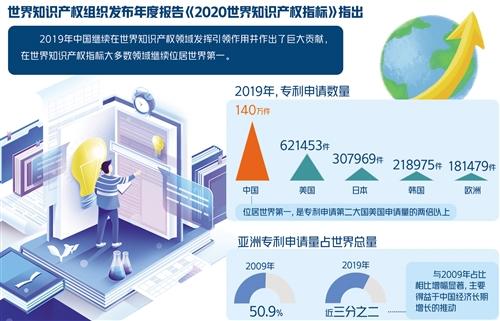The World Intellectual Property Organization report shows that
China continues to maintain its status as a strong country in intellectual property rights
Reporter Yang Haiquan from Geneva: On December 7, local time, the World Intellectual Property Organization (WIPO) released its annual report "2020 World Intellectual Property Indicators."
The report pointed out that although the global trademark and industrial design application activity continued to rise in 2019, there was a rare decline in patent applications.
According to data from the World Intellectual Property Organization, China’s long-term economic growth has continued to promote the significant development of global intellectual property rights. In 2019, China continued to play a leading role in the field of intellectual property rights in the world and made great contributions. the first.
The report collects and analyzes intellectual property data from the intellectual property authorities of more than 150 countries and regions, and aims to provide reference information for policy makers, business circles, investors, experts and scholars.
According to the report, the number of global patent applications in 2019 was 3.2242 million, a year-on-year decrease of 3%; the number of industrial design applications was 1.3609 million, a year-on-year increase of 1.3%; and the number of plant variety applications was 21,400, a year-on-year increase of 7.8%.
In 2019, the number of patent applications in China was 1.4 million, ranking first in the world and more than twice the number of patent applications in the United States (621,500), the second largest country in patent applications.
Following the United States are Japan (308,000 items), South Korea (219,000 items) and Europe (181,500 items).
The top 5 patent applications together account for 84.7% of the world's total.
As a country with strong intellectual property rights, the number of patent applications in China has declined for the first time in nearly 24 years. The main reason is that China has implemented an overall regulatory transformation aimed at optimizing the application structure and improving the quality of applications, which has led to a decline in its application volume.
Among the top ten countries in terms of global patent applications in 2019 are Germany (67,400), India (53,600), Canada (36,500), Russia (35,500) and Australia (29,800).
Among them, the number of patent applications in Canada and India has increased, while Australia, Germany and Russia have seen a decline.
In 2019, the number of patent applications in Asia accounted for nearly two-thirds (65%) of the world's total, which was a significant increase compared with the proportion of 50.9% in Asia in 2009, mainly due to the long-term economic growth of China.
The number of patent applications in North America was only slightly more than one-fifth (20.4%) of the world's total in 2019, and Europe accounted for slightly more than one-tenth (11.3%).
Africa, Latin America and the Caribbean and Oceania together accounted for 3.3% of the global total in 2019.
In terms of patent applications submitted by citizens overseas, in 2019, U.S. residents filed 236,000 patent applications overseas, maintaining the world's leading position in this regard.
Following the United States are Japan (206,800 pieces), Germany (104,700 pieces), China (84,300 pieces) and South Korea (76,800 pieces).
In 2019, the number of valid patents worldwide increased by 7% to approximately 15 million.
The United States has the largest number of valid patents (3.1 million), followed by China (2.7 million) and Japan (2.1 million).
More than half of the effective patents in the United States come from abroad, and the effective patents in Japan account for about 80%.
In terms of trademarks, there were approximately 11.5 million trademark applications worldwide in 2019, covering 15.2 million categories, a year-on-year increase of 5.9%, and growth has been achieved for ten consecutive years.
Among them, China has the largest number of applications, covering about 7.8 million categories; followed by the United States (672,700 categories) and Japan (546,200 categories), Iran (454,900 categories), and the European Union (407,700 categories).
Among the top 20, Brazil, Vietnam, Iran, Russia and Turkey have the fastest growth from 2018 to 2019, with growth of 22.3%, 19.3%, 18.4%, 16.5% and 15.5% respectively.
Asia accounted for 70.6% of all trademark filing activities in 2019, which is higher than the 38.7% in 2009.
Europe’s share fell from 36% in 2009 to 15.4% in 2019.
North America accounted for 5.7% of the world total in 2019.
Africa, Latin America and the Caribbean, and Oceania have a combined share of 8.3% in 2019.
In 2019, there were approximately 58.2 million valid trademark registrations worldwide, an increase of 15.2% over 2018. Among them, China alone had 25.2 million, ranking first, followed by the United States with 2.8 million and India with 2 million.
Deng Hongsen, Director-General of the World Intellectual Property Organization, said that the 2019 World Intellectual Property Indicators data show that the demand for intellectual property tools is showing a long-term growth trend and is driving the global economy toward more and more globalization and digitalization.
At the end of 2019, the vigorous use of intellectual property tools demonstrated a high level of innovation and creativity.
The new crown pneumonia epidemic has promoted the adoption of new technologies and promoted the digitization of daily life.
As intellectual property is closely related to technology, innovation and digitization, it will become more important to more countries in the post-epidemic era.

